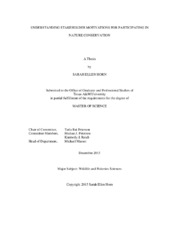| dc.description.abstract | Understanding what motivates stakeholders to participate in nature conservation is becoming increasingly important for developing effective conservation efforts in the midst of climate change. The intended outcomes of this type of research are improved policy making and implementation, and well-conceived and executed ecological restoration initiatives. In regions where sound biological knowledge exists, yet abundance of at-risk species continues to decline, it is particularly important for conservation scientists to understand stakeholder motivations. Natural resource management collaborative processes and focus groups are two methods that are useful for gaining insight into stakeholder motivations for conserving nature.
A collaborative management process sponsored by the Mission-Aransas National Estuarine Research Reserve (NERR) provided an opportunity to study motivations for participating in collaborative natural resource management. For this study we used a survey to identify stakeholders’ motivations for participating in the Mission-Aransas NERR collaborative process by asking them what they think is important for the group to accomplish, the important roles they and other participants performed, and their reasons for continued participation. We found that opportunities to share information, the ability to play a wide variety of roles in the collaborative process, and contribution to closer connections between science and policy motivated these participants.
We used the situation surrounding the decline in northern bobwhite and other grassland bird abundance across Texas as a case study to explore stakeholder motivations for conserving these species. We conducted focus groups across 10 ecoregions in Texas to assess the motivations of landowners, land managers, quail hunters, conservationists, and general public for participating in bobwhite and grassland bird conservation. Specifically, we were interested in whether stakeholders were motivated by their values, including culture, intrinsic values, ecosystem, policy, economic, and education. We found that these values are shared by all stakeholders interested in conservation, and occur in many variations depending on the values most important to an individual. | en |


